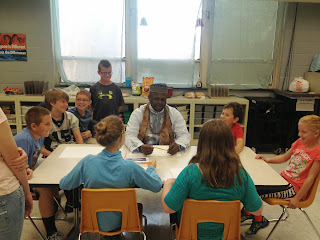For an extended lesson on flight, students created paper helicopters. These paper helicopters spin gracefully as they fall slowly through the air. They’re quick and easy to make. They can even be released from a paper airplane during a loop-the-loop!
The helicopters are constructed from a narrow strip of ordinary or colored paper. We first used a template to cut and create our flyers. Afterwards students created larger models on their own. Our students decorated their helicopters with unique patterns and colors. They looked spectacular as they spiraled down. Flying requires a large space with high ceilings (eg school hall, gymnasium) or outdoors if winds and weather permit. We were able to make use of a second story balcony.
When our students dropped their paper Helicopter from a distance, air pushed up against the blades, bending them up just a little. When air pushes upward on the slanted blade, some of that thrust becomes a sideways, or horizontal, push.
Why doesn't the copter simply move sideways through the air? That's because there are two blades, each getting the same push, but in opposite directions. The two opposing thrusts work together to cause the copter to spin.
Things to Notice/Question:
When you drop your copter, take notice of which direction it spins as it falls. Is it clockwise or counterclockwise?
Does the weight (the number of paper-clips on the stem) change the spin?
Which combination made the best spinning helicopter?
How can you change your spin? What if you bend the blades in the opposite direction?
Terms: Lift
Lift is created by different airspeed above and below an airfoil.
[To illustrate this, take a standard rectangle piece of paper with your hands holding two corners, adjacent to each other(preferably, take the long end of the paper). For this demonstration, the part of the paper you are holding should be level, with the opposite end curving downward. Next, blow downward and across on the paper. Almost magically, the end of the paper lifts! Why is this? Basically, the higher airspeed on top of your paper "airfoil" creates less pressure above the paper, causing the higher pressure below the paper to raise it up slightly.]
Looking for your own flying helicopter Template?



























